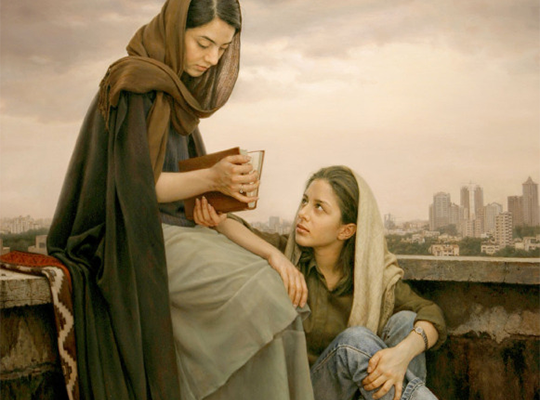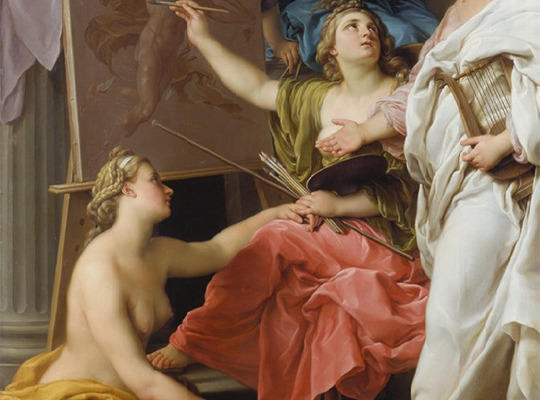#iman maleki
Explore tagged Tumblr posts
Text



Iman Maleki, “Dizziness” (1998).
“Costruiamo storie per dare senso, per cercare di mettere ordine nel caos. E le storie, a ben vedere, sono tutto quello che abbiamo.”
― Gianrico Carofiglio, “L’orizzonte della notte”.
#iman maleki#dizziness#art#painting#contemporary art#artist#oil on canvas#reading#books#gianrico carofiglio#l’orizzonte della notte#costruire#storie#dare#senso#cercare#mettere#ordine#caos#vedere#essere#tutto#quello#avere#libri#frasi libri#quotes
30 notes
·
View notes
Text

Iman Maleki, Memory of that house
144 notes
·
View notes
Text

Studying by Iman Maleki, 1998 Oil on canvas, 91 × 50 cm source.
2 notes
·
View notes
Text

______________: Não, não é uma foto…
É uma pintura a óleo chamada "Só com o mar".
Foi realizada pelo pintor hiper-realista iraniano Iman Maleki, nascido em Teerã em 1976.
37 notes
·
View notes
Text

Iman Maleki, Mareo
39 notes
·
View notes
Text

Iman Maleki - Omens of Hafez, 2003
17 notes
·
View notes
Text
https://www.nytimes.com/2024/11/27/movies/the-seed-of-the-sacred-fig-review.html
The ubiquity of smartphones capable of filming anything, anywhere, has been a blessing and a curse to autocratic governments. On the one hand, protests and nascent revolutions can be filmed and broadcast, seen around the world, making the authoritarian’s attempt to quash dissent much more onerous.
But there’s a shadow side. Autocrats can compel obedience by means of overt force, but it’s much more canny — and more insidious — to turn everyone into individual agents of surveillance. Thinking your office might be wiretapped is bad enough, but knowing whatever you do might be filmed by your snitch neighbor, or sibling, is a powerful motivator to fall into line even in the private sphere. And those phones? They’re perfect little monitoring machines.
This possibility is a basic fact of 21st-century life, and Mohammad Rasoulof makes powerful use of it in his drama “The Seed of the Sacred Fig.” Titles before the film begins announce that it was made in secret, because “when there is no way, a way must be made.” In the past, Rasoulof’s films have resulted in travel bans and prison sentences in his native country of Iran, where he’s run afoul of strict censorship laws. When “The Seed of the Sacred Fig” was announced as a selection at this year’s Cannes Film Festival, the Iranian government interrogated the cast and crew, subjecting them to travel bans. On May 8, less than a week before the start of the festival, Rasoulof was sentenced to flogging and eight years in prison. He and several of the film’s crew fled their country for Europe, and he remains in exile.
It’s not hard to see why the film seemed so dangerous. It puts a frame around inconvenient truths. The main drama concerns a family of four: Iman (Missagh Zareh), his wife, Najmeh (Soheila Golestani), and their two daughters, 21-year-old Rezvan (Mahsa Rostami) and her teenage sister, Sana (Setareh Maleki). Iman has recently been made an investigating judge in Tehran’s revolutionary court, a position of prestige, and Najmeh is overjoyed. Iman aspires to do his job justly.
But almost as soon as he arrives, he discovers that among his duties is a morally dubious one: rubber-stamping severe sentences as requested by the regime’s prosecutors, instead of doing the work of investigating them first. He’s also given a gun to protect himself and his family. Torn at first, he tells his wife about what he’s been asked to do. He and Najmeh reason that the country’s laws are God’s laws, and that it is not his moral responsibility to cross the prosecutors’ recommendations. Besides, what they wish for most is safety, stability and prosperity for their family. That is what the state provides.
Their daughters take a different view. They’re observing protests against the government through many windows — the ones in their bedroom, but also the ones into the world their phones provide. Often what they see on state TV conflicts sharply with the evidence of their own eyes. After Rezvan’s friend Sadaf (Niousha Akhshi) is shot in the face during a protest against compulsory hijab wearing, Iman tells his daughters they’re believing lies planted by the enemy. And then, his gun goes missing.
This story unfolds slowly and methodically, mostly contained in the family’s apartment — no wonder, given the film was shot in secret. But the small-scale family drama feels like a model of the full country in miniature. As the members of the family become more suspicious, they turn on one another. Home begins to feel like a prison of its own.
“The Seed of the Sacred Fig” — the title refers to a tree in which the young shoots choke out the older trunk — is a slow burn, sometimes a tad too slow. Occasionally languid, close-cropped shots that seem intended to produce visual poetry go on a bit too long.
But those sequences are a minor distraction, and the rest of the film’s methodical pace, its deliberate unfolding of the family’s growing rifts, feels almost classical, as if we’re watching an old legend fitted to a new age. Each of the main cast ably portrays internal conflict, both in the things they say and the things they don’t.
There’s a clear divide between the public and private realms in their world (each woman wears a hijab outside the house, a visual separation). The film dwells occasionally on the simple moments of home life: cooking dinner, sitting together in the living room, listening to music. So as the family’s phones become key players in the story, it’s clear what kind of intrusion they represent — the outside world entering the contained indoor one, and the possibility of the opposite occurring.
Rasoulof brilliantly takes this a step further. As his characters wrestle increasingly with the turmoil outside their doors, and the implications this might have for the order within, the film cuts away from this drama and takes us to another drama. Suddenly, what we’re seeing is real: vertically shot documentary footage of protests on the streets, presumably captured by citizens. Those protests followed the death of a woman named Mahsa Amini while she was in police custody in Tehran in September 2022. The footage involves authorities cracking down on protesters, brutal beatings and worse.
It’s an extraordinarily brave addition on Rasoulof’s part, and an effective way to break the film’s fourth wall. That’s footage you, too, could have seen on your phone. “The Seed of the Sacred Fig” asks us to enter a family’s story, but also to acknowledge that we are part of it. We’re extras in the background, no matter how far away we are. For Rasoulof, the world he’s created is far from theoretical. The consequences have been, too.
0 notes
Video
youtube
DIE SAAT DES HEILIGEN FEIGENBAUMS | HD Trailer (German)
"Die Saat des heiligen Feigenbaums" (Originaltitel: دانهی انجیر معابد, international bekannt als The Seed of the Sacred Fig) ist ein Spielfilm von Mohammad Rasoulof aus dem Jahr 2024. Das Drama erzählt die Geschichte eines iranischen Ermittlungsrichters, der während der landesweiten politischen Proteste gegen das autoritäre Regime zunehmend von Misstrauen und Paranoia gegenüber seiner eigenen Familie geplagt wird. Die Hauptrollen spielen Missagh Zareh, Soheila Golestani, Mahsa Rostami und Setareh Maleki. Der Film verwebt fiktive Szenen mit realen Aufnahmen der blutig unterdrückten Proteste durch die iranischen Behörden.
Iman (Iman Misagh Zareh) wird zum Untersuchungsrichter am Revolutionsgericht in Teheran befördert, als das Land von einer massiven Protestbewegung erschüttert wird. Der Tod einer jungen Frau wird zum Auslöser der Demonstrationen, die immer intensiver werden und auf zunehmend harte Gegenmaßnahmen des Regimes stoßen. Iman stellt sich auf die Seite des Staates, was nicht nur seine eigene psychische Belastung verstärkt, sondern auch die Harmonie in seiner Familie gefährdet.
Während seine Töchter Rezvan (Mahsa Rostami) und Sana (Setareh Maleki) von den Ereignissen tief bewegt und aufgerüttelt sind, versucht seine Frau Najmeh (Soheila Golestani) verzweifelt, die Familie zusammenzuhalten. Die Situation spitzt sich weiter zu, als Iman feststellt, dass seine Dienstwaffe verschwunden ist, und er beginnt, Verdacht gegen seine eigene Familie zu hegen.
Hintergrund Mohammad Rasoulof erzählt in seinem intensiven Politthriller von den Protesten im Iran im Herbst 2022 und zeichnet ein schonungsloses Bild eines repressiven Regimes. Der Film, unter schwierigen Bedingungen im Iran gedreht, wurde bei den 77. Filmfestspielen von Cannes mit Standing Ovations und mehreren Preisen, darunter der Spezialpreis der Jury, ausgezeichnet.
#youtube#DieSaatDesHeiligenFeigenbaums#Passion of Arts#Dein Fenster zur Filmkunst#TheSeedOfTheSacredFig#MohammadRasoulof#IranianCinema#PoliticalDrama#ProtestFilm#AutoritäresRegime#Film2024#CannesFilmFestival#Oscarbeitrag#IranProteste#Spielfilm#FiktionUndRealität#GoldenerBärGewinner#MissaghZareh#SoheilaGolestani#MahsaRostami#SetarehMaleki#NioushaAkhshi#RezaAkhlaghi#ShivaOrdooei#AminehArani#Politthriller#DramaFilm#IndependentFilm#ArteKoproduktion#RunWayPictures
0 notes
Text

Sunlight by Iman Maleki, 2004 Oil on canvas, 107.5 × 60 cm source.
0 notes
Text
Luz Solar-Iman Maleki(1976)
Tela de Iman Maleki, pintor iraniano do hiper-realismo Indicado pelo professor Luiz Carlos de Oliveira e Silva

View On WordPress
0 notes
Photo

‘Portrait of a Man’ painted by Iranian realist painter Iman Maleki (born 1976). He has been putting on exhibitions since 1998, mostly in his own country. Here is his website.
197 notes
·
View notes
Photo




Omens of Hafez, 2003. Imān Maleki (Iranian, b. 1976)
The Russian Bride’s Attire, 1889. Konstantin Makovsky (Russian, 1839-1915)
Allegory of the Arts, 1740. Pompeo Batoni (Italian, 1708-1787)
The Reluctant Bride, 1866. Auguste Toulmouche (French, 1829-1890)
#Imān Maleki#Iman Maleki#Konstantin Makovsky#Pompeo Batoni#Auguste Toulmouche#women in art#compilation#*#🌹
4K notes
·
View notes
Text


İman Maleki dünyanın en iyi hiperrealist (en gerçekçi) ressamı seçilmiş... önce 1. resme sonra detayı görmek için 2. resme bakın
39 notes
·
View notes


